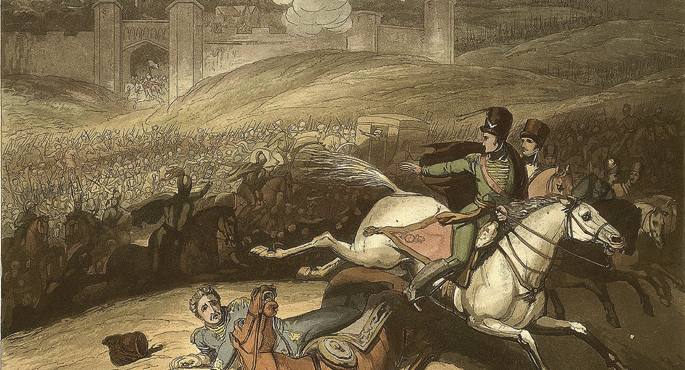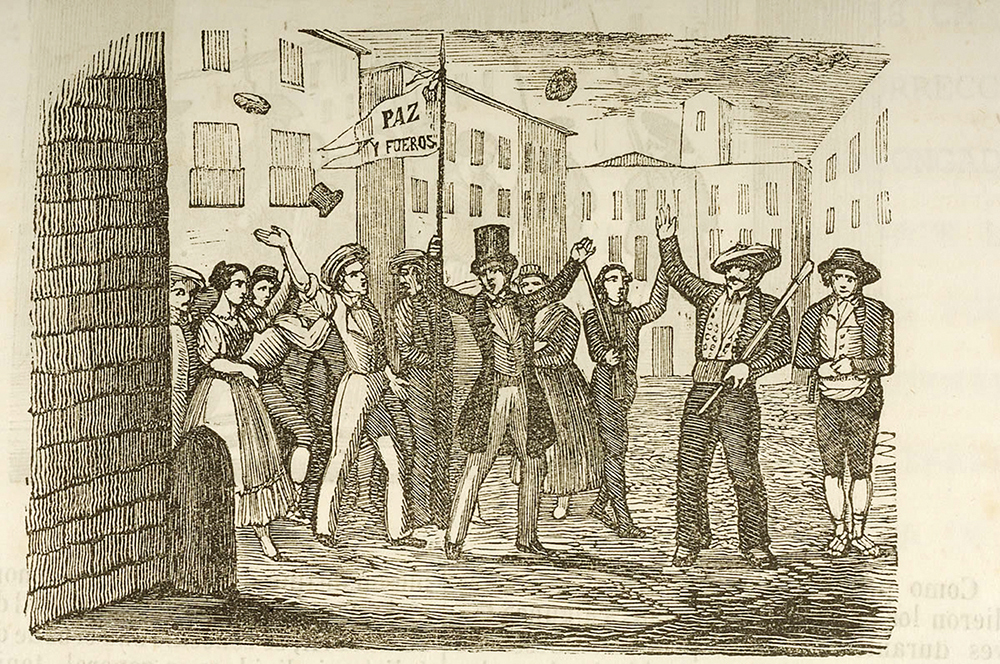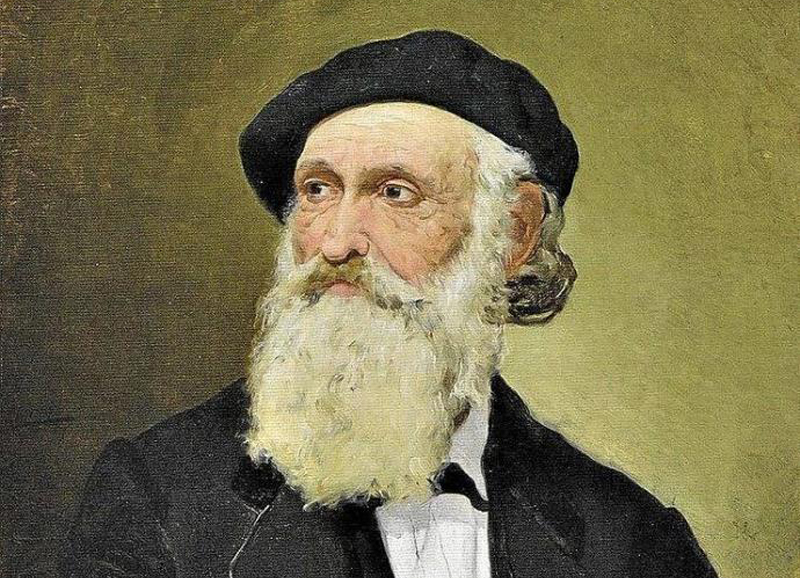A struggle that decided the future of Europe
- In Vitoria-Gasteiz anyone can identify the monument that is in the Plaza de la Virgen Blanca. Bonapartist remembers the battle he lost 200 years ago. Compulsory image in tourist guides. This is an event that also has a prominent presence in the street and that, however, is not well known by the Vitorians. At the international level, however, Vitoria-Gasteiz was placed on the map of Europe.

At the beginning of the 21st century, when the reform project of the Plaza de la Virgen Blanca of Vitoria-Gasteiz was launched, an intense debate arose with the monument at its center, for aesthetic reasons. Few knew exactly what this monument wanted to remember, and for many the main reason not to have to take it away was “because it has always existed”. The monument, built in 1917 to commemorate the centenary of the Battle of Vitoria in 1813, is the work of the sculptor Gabriel Borras in stone and bronze. It bears the slogan “Gasteizko Batailari” and at the bottom also the controversial phrase “To the independence of Spain”.
Throughout Europe, the war of interests, tactics and games had spread since Napoleon began the expansion of his empire. In that war between several countries, each one defended himself, and the institutions and citizens of the Basque Country also acted in this way. Well, it was up to Vitoria-Gasteiz to become the decision-making centre of that great and complicated battle. It was the penultimate breath of the Napoleonic Empire, the last one that took place in Waterloo. Since then, the name of the Alavesa capital has been found in numerous European places and writings.
Emilio Larreina is aware of the importance that the Battle of Vitoria of 1813 has abroad. While his son was studying in Scotland, a university professor asked him about the “Vitoria de Wellington”. He replied that his father was a specialist in the Battle of Vitoria. “Since then, my son would not live in college, but in the teacher’s house.”
Larreina is president of the Gasteiz Historical Association 2013. One of the most concrete books on the subject (The Battle of Vitoria 1813. The end of the adventure). When he made the journey of the battle for the writing of the book, it was quite common for him to find English. “Today they know more about the battle in England than in Vitoria.” This is also stated by the secretary of the association, Patxi Viana.
The whim of the English, the salvation of the French
During the War of the Iberian Peninsula or the War of Spanish Independence (1808-1814), Vitoria became a strategic center. After losing at Bailén, José Bonaparte set his court at the Montehermoso Palace. The peak of the occupation took place on June 21, 1813, the day of battle.
“Sixty thousand soldiers arrived at Napoleon,” says Lark, and the following day 80,000 ‘allies’ (British, Portuguese, Spanish…) were ready to oppose. In the Alavesa plains, 170,000 people were concentrated, which would not be seen until the 1970s. On the day of battle, at 8 a.m., citizens began to hear the guns. All day listening to guns, getting closer: first in the mountains, then in the plain…”.
The excessive weight the French carried in their flight was of great importance in the epilogue of the battle. The natural road from Vitoria to France, which runs through the valley of the Deba, was cut to the height of the town of Durana. Therefore, the neighbours of Salvatierra/Agurain today moved to the Saint Lucia district of the capital of Alavesa. Following this path they had to cross a hill. It was impossible to go with the carriages, and the military and other fleeing families had to abandon everything they were carrying. A verse from then says:
Cars and scavengers, literas and
more irons, have remained in Bitoria with all their fortune, and the artillery is there closed, not very embarrassing for the kings of the franceses.Las allied troops suspended the persecution to collect this treasure, which apparently did nothing to
General
Wellington, who saved most of the French army.
Despite the fact that Vitoria-Gasteiz was spared without suffering any damage – since in the city General Miguel Ricardo de Álava, who possessed a large quantity of goods, had intervened – the same did not happen with the villages that the French visited later on. Hungry and thirsty they came to Salvatierra and looted the people.
Horrors of occupation
The Vitorians lived this battle locked up at home, not knowing what was going to happen. “The defeat of the French was a real liberation for the Vitorian society,” says José María Ortiz de Orruño.Ortiz of Orruño is a Doctor in Contemporary History by the UPV/EHU and a member of the Gasteiz Association 2013: “They suffered looting and suffocating taxes for six years of occupation.” About 1800 people lived in Vitoria-Gasteiz 6,500 inhabitants. At the time of the war, however, they came to have more than 20,000, including troops.
According to Ortiz de Orruño, life inside the walls was very extravagant, there were no soldiers barracks or oven to make bread for so many people: "The soldiers stayed in the homes of the citizens, depending on the category in which they were. The counties and the marquis received the generals and the citizens from the simple soldiers.”
Livestock also suffered a drastic reduction due to overpopulation. The peasants lost their pairs of oxen and their animals. The Grand Duke was made available to the soldiers, both to transport the material and to eat without wasting time. “They also lost the crops, as they were used to feed livestock. That battle brought hunger for the whole year, because it occurred at the time of harvest,” explains the professor of the UPV/EHU.
The precedent of progressive taxation?
At the Vienna Assembly (1819) an international agreement was signed to compel France to pay for the tragedies that had caused it. To compensate for the losses, the Basque deputies reported all the damage. In the end, they did not receive anything, because Spain, without being a great power, had lost all pressure capacity. Ortiz de Orruño is clear: “After the Prussians, the Austrians and all the others were charged, when the deputies’ turn came, there was no money.”
It is often said that the French rationalized the treasury proportionally during the occupation. Well, the professor gives us a little nuance: “It wasn’t about making a more just society, it was about exploiting the population.” According to Napoleonic politics, the occupation had to be paid by the occupants. When in 1810 Álava, Bizkaia and Gipuzkoa remained in a single administrative district under the command of General Thouvenot, the emperor made it clear to him that he would not send him money from Paris.
To cope with this situation, Thouvenot introduced two innovations: the universality of taxes – which everyone had to pay, including nobility and clergy – and proportionality – which is paid on the basis of individual wealth. However, these liberal measures had their shadow: To reward the contribution to the “imperial cause”, the receipts were accepted as money in the auction of public goods, that is, pieces of paper that were worthless.
“It’s Spanish who doesn’t want to be anything else”
For Emilio Larreina this is paradoxical. Three or four years after the loss of Napoleon in Vitoria and Waterloo, the whole of Europe stands up because “they want to be citizens and non-sovereign”.
The abstract concept of national identity must be understood as the development of freedoms and rights, both in the Basque Country – the ultimate expression of the tension between liberalism and traditionalism in the Carlist wars – and throughout Europe. In the words of Ortiz de Orruño “the fundamental concepts for us – freedom, equality – were nothing but a nonsense for peasants and peasants without studies 200 years ago”.
However, the French model of “freedoms and rights” has left other consequences. Only half of the population living in France in the early nineteenth century knew French. There was talk of Basque, Bearnese, Occitan, Breton, German and other languages. Eugene Weber describes in Peasants Into Frenchmen that a long process has emerged from that reality today.
Many factors have influenced, but the most important thing has been the nationalizing capacity of the French State, through the Republican army and school: “France and Spain are very different realities. In France, since the end of the 19th century, they have been very clear about what it is to be French, and they want to be so because of its advantages. The opposite is true in Spain. As Cánovas del Castillo said: ‘The only thing that can be is Spanish,’ says Ortiz de Orruño.
Learning from memory
The Historical Society Vitoria-Gasteiz 2013 was born three years ago from the hand of several people, with the objective of contributing each from its scope. So far they have organized a series of events and still have a long list to follow up on the subject: routes through the Vitoria Bonapartista and the battlefield of 1813; the project of staging the battle; guided visits to the Museo de Armas de Álava on the occasion of the 150th anniversary… Several projects related to the memory of the battle have also been launched. For example, they will publish the biography of General Álava and his personal archive through an agreement with the Sancho el Sabio Foundation.
The agents of the association believe that the issue can have a great tourist attraction if it is taken advantage of well. Vitoria-Gasteiz could enter the European network of Napoleonic cities: “They want to know the activities that are going to be carried out in many places in Europe to commemorate the bicentenary,” says Viana.
The Culture Department of the Diputación de Álava has provided EUR 80,000 for the commemorative events – among others, the sword of General Álava, of the National Army Museum – and another EUR 95,000 for the municipality of Vitoria-Gasteiz: According to the councilwoman of Culture of pp, Encina Serrano, the anniversary will be "an important part of the cultural programming of the city". However, the different political views of the opposition parties and the economic crisis have not brought any agreement on the anniversary.
Ortiz de Orruño is reminded of the Latin phrase “Si vis pacem, para bellum”. If you want peace, get ready for war. And it turned. “If you want peace, don’t forget the horrors of war. Although Europe does not live at its best, we must not forget that there were worse moments. And at that time, Vitoria-Gasteiz became a fundamental reference.”
200 urte beteko dira abuztuan Jose Mari Iparragirre jaio zenetik eta haren bizitza kontatuko lukeen pelikula biografikorik gabe jarraitzen dugu, biopic baterako materiala soberan dagoen arren: gudari, kantari, seduktorearen historia dago, batetik, heroi nazional bihurtu zen... [+]
140 urte bete dira Kontzertu Ekonomikoa sortu zela Araba, Bizkaia eta Gipuzkoarentzat. Euskal erakundeek garrantzi handiz ospatu dute teorian porrot baten emaitza dena, foruen abolizioaren ondoren, gure burujabetzaren azken hondar gisa hartu izan da zerga sistema berezia.
Ez hain antzina, hiru mende atzera gehienera, kostako herri baten ur territorialak kanoi baten tiramenaren arabera zehazten ziren: jaurtigaia noraino heldu, lehorretik harainokoa izango zen ur territoriala. Lurraldearen zedarritzeko, ordea, kanoia baino hobea da festa, eta hain... [+]
Amikuzeko Zabalik elkartearen otsail ostegunetako zita klasiko bihurtzeko bidean da. Aurten zer antolatu duten iragarri dute eta, gaien ugaritasuna eta gaurkotasuna ikusirik, emango dute zeresan franko.























